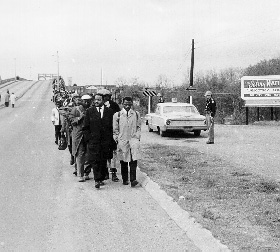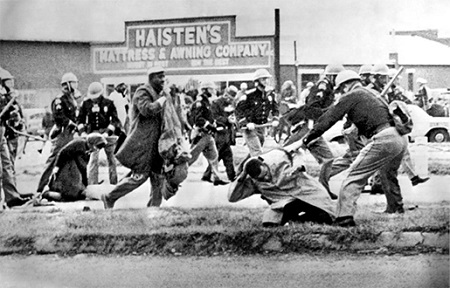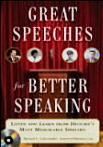
|
Rep John Lewis (D-Georgia) Edmund Pettus Bridge Address delivered 7 March 2015
[AUTHENTICITY CERTIFIED: Text version below transcribed directly from audio]
My
beloved brothers and sisters, We, as a nation, have a great deal to be thankful for. Jimmie Lee Jackson! Jimmie Lee Jackson, whose death inspired the Selma march, along with so many others, did not make [it] to see this day. But you and I are here. We can bear witness to the distance we have come and the progress we have made in 50 years. And we must use this moment to recommit ourselves to do all we can to finish the work. There’s still work left to be done. Get out there and push and pull, until we redeem the soul of America. Now I want to thank President Barack Obama and Mrs. Obama, President George [W.] Bush and Mrs. Bush for being here today. I want to thank all the members of the Cabinet and the Administration who are here; my colleagues in the Congress; all the elected officials, including the great governor, Robert Bentley; including the Mayor of Selma, George Evans; and all of the American people. I would like for all members of the Congress in our delegation just to stand. Thank you. I want to thank the Faith and Politics Institute for bringing us together one more time; and the co-leaders of our delegation, Senator Tim Scott, Senator Sherrod Brown, Representative [Terri] Sewell and Representative Martha Roby. Thank you so much. It is good to see Mrs. [Amelia] Boynton who was our first contact when we came to Selma in 1962. She was registering people to vote here long before we arrived. Also glad to see the daughter of Governor George Wallace here, Peggy Wallace Kennedy. Thank you for being here, Peggy. And I want to thank each and every one of you who marched across the bridge on Bloody Sunday. You didn't have to do it but you did it. Thank you! I tell you it's good to be in Selma one more time, just one more time. People often ask me, "Why do you come back?" "What purpose does it serve?" We come to Selma to be renewed. We come to be inspired. We come to be reminded that we must do the work that justice and equality calls us to do.1 On March 7th, 1965, a few innocent children of God, some carrying only a bedroll, a few clutching a simple bag, a plain purse or a backpack, were inspired to walk 50 dangerous miles from Selma to Montgomery to demonstrate the need for voting rights in the state of Alabama.
On that day, on that day, 600 people marched into history, walking two by two down this sidewalk, not interfering with the free flow of trade and commerce, not interfering with traffic, with a kind of military discipline.
We were so peaceful, so quiet, no one saying a word. We were beaten, tear-gassed. Some of us was left bloody right here on this bridge. Seventeen of us were hospitalized that day. But we never became bitter or hostile. We kept believing that the truth we stood for would have the final say. This city, on the banks of the Alabama River, gave birth to a movement that changed this nation forever. Our country will never, ever be the same because of what happened on this bridge. Eight days after Bloody Sunday, the President of the United States, Lyndon Baines Johnson, delivered one of the most meaningful speeches ever made by any President on the question of voting rights.2 He said, "The time of justice has [now] come. I believe sincerely that no force can hold it back." He went on to say, "It is right in the eyes of man and God that it should come." He said, "At times, history and fate History and fate meet at a single time and a single place to shape a turning point in man's unending search for freedom." He went on to say, "So it was at Lexington and Concord. So it was [a century ago] at Appomattox. So it was [last week] in Selma, Alabama." Each of us must go back to our homes after this celebration and build on the legacy of the March in 1965. The Selma Movement is saying today that we all can doing something. So I say to you, don't give up on the things that have great meaning to you. Don't get lost in a sea of despair. Stand up for what you believe. Because in the final analysis, we are one people, one family, the human family. We all live in the same House, the American House, the world House. We're black. We're white. We are Hispanic, Asian-American, Native-American. But we're one people. Thank you.
1 Anaphora 2 Johnson, L.B. (15 March 1965). Address to a Joint Session of Congress on Voting Legislation.
Original Audio Source:
C-SPAN.org
Audio Note: AR-XE = American Rhetoric Extreme Enhancement
Image #1 Source:
https://www.loc.gov/item/today-in-history/march-07/
(and quoted directly from source.)
Image #2 Source: https://obamawhitehouse.archives.gov/blog/2015/08/06/50-years-ago
Page Updated: 1/13/22 U.S. Copyright Status: This text and audio = Property of AmericanRhetoric.com. Images = Fair Use. |
|
|
© Copyright 2001-Present. |



